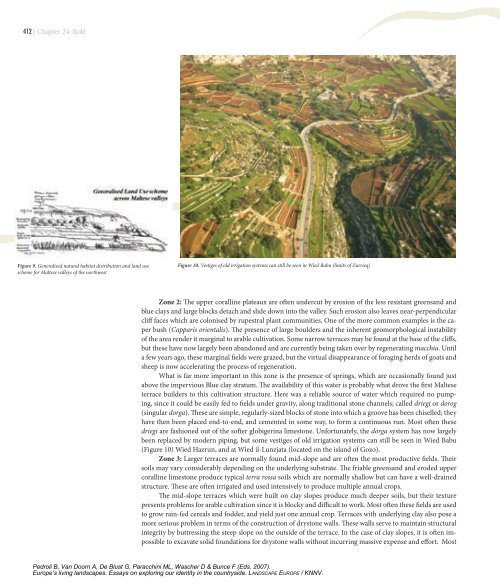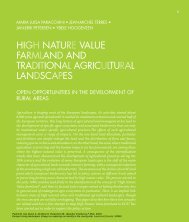The Terraced landscapes of The MalTese Islands - Landscape Europe
The Terraced landscapes of The MalTese Islands - Landscape Europe
The Terraced landscapes of The MalTese Islands - Landscape Europe
You also want an ePaper? Increase the reach of your titles
YUMPU automatically turns print PDFs into web optimized ePapers that Google loves.
12 | Chapter 24: Rolé<br />
Figure 9. Generalised natural habitat distribution and land use<br />
scheme for Maltese valleys <strong>of</strong> the northwest<br />
Figure 10. Vestiges <strong>of</strong> old irrigation systems can still be seen in Wied Babu (limits <strong>of</strong> Zurrieq)<br />
Zone 2: <strong>The</strong> upper coralline plateaux are <strong>of</strong>ten undercut by erosion <strong>of</strong> the less resistant greensand and<br />
blue clays and large blocks detach and slide down into the valley. Such erosion also leaves near-perpendicular<br />
cliff faces which are colonised by rupestral plant communities. One <strong>of</strong> the more common examples is the caper<br />
bush (Capparis orientalis). <strong>The</strong> presence <strong>of</strong> large boulders and the inherent geomorphological instability<br />
<strong>of</strong> the area render it marginal to arable cultivation. Some narrow terraces may be found at the base <strong>of</strong> the cliffs,<br />
but these have now largely been abandoned and are currently being taken over by regenerating macchia. Until<br />
a few years ago, these marginal fields were grazed, but the virtual disappearance <strong>of</strong> foraging herds <strong>of</strong> goats and<br />
sheep is now accelerating the process <strong>of</strong> regeneration.<br />
What is far more important in this zone is the presence <strong>of</strong> springs, which are occasionally found just<br />
above the impervious Blue clay stratum. <strong>The</strong> availability <strong>of</strong> this water is probably what drove the first Maltese<br />
terrace builders to this cultivation structure. Here was a reliable source <strong>of</strong> water which required no pumping,<br />
since it could be easily fed to fields under gravity, along traditional stone channels; called driegi or dorog<br />
(singular dorga). <strong>The</strong>se are simple, regularly-sized blocks <strong>of</strong> stone into which a groove has been chiselled; they<br />
have then been placed end-to-end, and cemented in some way, to form a continuous run. Most <strong>of</strong>ten these<br />
driegi are fashioned out <strong>of</strong> the s<strong>of</strong>ter globigerina limestone. Unfortunately, the dorga system has now largely<br />
been replaced by modern piping, but some vestiges <strong>of</strong> old irrigation systems can still be seen in Wied Babu<br />
(Figure 10) Wied Hazrun, and at Wied il-Lunzjata (located on the island <strong>of</strong> Gozo).<br />
Zone 3: Larger terraces are normally found mid-slope and are <strong>of</strong>ten the most productive fields. <strong>The</strong>ir<br />
soils may vary considerably depending on the underlying substrate. <strong>The</strong> friable greensand and eroded upper<br />
coralline limestone produce typical terra rossa soils which are normally shallow but can have a well-drained<br />
structure. <strong>The</strong>se are <strong>of</strong>ten irrigated and used intensively to produce multiple annual crops.<br />
<strong>The</strong> mid-slope terraces which were built on clay slopes produce much deeper soils, but their texture<br />
presents problems for arable cultivation since it is blocky and difficult to work. Most <strong>of</strong>ten these fields are used<br />
to grow rain-fed cereals and fodder, and yield just one annual crop. Terraces with underlying clay also pose a<br />
more serious problem in terms <strong>of</strong> the construction <strong>of</strong> drystone walls. <strong>The</strong>se walls serve to maintain structural<br />
integrity by buttressing the steep slope on the outside <strong>of</strong> the terrace. In the case <strong>of</strong> clay slopes, it is <strong>of</strong>ten impossible<br />
to excavate solid foundations for drystone walls without incurring massive expense and effort. Most<br />
Pedroli B, Van Doorn A, De Blust G, Paracchini ML, Wascher D & Bunce F (Eds. 2007).<br />
<strong>Europe</strong>’s living <strong>landscapes</strong>. Essays on exploring our identity in the countryside. LANDSCAPE EUROPE / KNNV.




